Fluoride: Improving the Safety of the Public Water Supply
When Grand Rapids, Michigan, became the first city to add fluoride to its water supply in 1945, the decision was hailed as a major public health innovation aimed at preventing cavities. Many other cities quickly followed suit, and water fluoridation became a widespread practice nationwide.
For decades, fluoride has quietly flowed through our taps, touted as a safeguard for dental health. But what if this commonly accepted chemical—long promoted for its benefits to teeth—is something you’d prefer to avoid?
Push to End Fluoridation
A February systematic review and dose-response meta-analysis published in Environmental Research linked excessive fluoride exposure to thyroid issues, and a 2016 National Toxicology Report noted an association between fluoride and lowered IQ in children.Pharmacist and thyroid specialist Izabella Wentz echoed these concerns. She told The Epoch Times, “Reducing fluoride exposure is crucial for supporting overall health and well-being.”
How to Remove Fluoride From Your Water at Home
As the debate over fluoridation in public water systems continues, many households are opting to address the issue themselves. Below are some of the most popular methods for reducing fluoride exposure at home.Reverse Osmosis Systems
Reverse osmosis (RO) systems are highly effective at removing fluoride and other contaminants from drinking water, filtering out up to 84 percent through a semipermeable membrane. This purification process forces water through the membrane, leaving impurities behind. Fluoride expert Richard Sauerheber told The Epoch Times that modern RO systems can operate for years with minimal maintenance while effectively reducing fluoride levels.However, RO systems have certain drawbacks. According to Tom Volinchak, author of “Open Tap: Drink Poison,” they can produce up to 17 gallons of wastewater for every gallon of filtered water and remove beneficial minerals, which may need to be reintroduced for taste and health benefits.
Activated Alumina Filters
Activated alumina filters, such as Berkey’s PF-2, can remove up to 97 percent of fluoride and provide a convenient countertop solution that requires no plumbing or electricity. These filters use aluminum oxide to capture fluoride molecules on their porous surface.However, there are concerns that small amounts of aluminum may be released into the water, and in alkaline conditions, these filters may leach harmful aluminum-fluoride complexes. Filters must be replaced regularly, typically after 1,000 gallons, and some users report a decline in water quality over time.
Bone Char Filters
Bone char is another option for filtering fluoride from drinking water. Made from crushed animal bones heated in a kiln under low-oxygen conditions, bone char naturally absorbs fluoride and other contaminants, such as heavy metals, making it an effective filtration tool. Bone char’s ability to trap fluoride raises an important question: If animal bones can absorb fluoride so effectively, what impact might fluoride have on the bones in our own bodies?Bone char filters work through adsorption, in which fluoride molecules adhere to the surface of the char as water passes through. However, its filtration lifespan can be unpredictable, varying with fluoride levels, and requires regular monitoring and replacement.
Ion Exchange Systems
Ion exchange systems use resin beads to replace fluoride ions with less harmful ions, such as chloride, effectively lowering fluoride levels. However, these systems come with environmental concerns—plastic resin beads contribute to plastic waste, and aging filters may release microplastics or concentrated fluoride.Limitations of Certified Filtration Products
Volinchak pointed out that not all filtration systems perform as effectively as their certifications suggest. Organizations like the Water Quality Association and the National Sanitation Foundation certify filters based on their ability to remove a specific percentage of contaminants. However, these certifications do not guarantee that the filtered water is entirely safe to drink.Distillation: A DIY Approach
For those seeking a more hands-on method to remove fluoride, distillation provides a reliable, though labor-intensive, solution. This process involves boiling water and collecting the steam, which is then condensed back into liquid, leaving fluoride and other contaminants behind. However, distilled water lacks minerals, which many people find results in a flat or bland taste.“Distillation works well but requires labor on the part of the consumer,” Sauerheber said. According to him, it is essential to remineralize the water to avoid drinking overly purified, mineral-deficient water.
While distillation is highly effective at removing fluoride, it requires time, equipment, and the additional step of reintroducing essential minerals.
For those looking for a more convenient solution, water distillation machines offer an automated approach to fluoride removal. Distillation units are available in various sizes, from compact countertop models to larger units suited for higher volume needs.
5 Ways to Reduce Your Fluoride Burden
Reducing fluoride exposure is important for maintaining health. If you have already been exposed or live in an area with high fluoride levels, there are steps you can take to mitigate its effects. While no supplements can directly neutralize fluoride, certain nutrients and lifestyle changes may support the body’s natural detoxification processes.1. Be Mindful of Fluoride in Foods and Products
Beyond water, fluoride can sneak into your daily routine through common foods, beverages, and products. Wentz said that black and red teas and certain medications are hidden sources of fluoride because tea plants absorb fluoride from the soil. Additionally, foods processed with fluoridated water and certain pesticides can introduce fluoride into your diet, further contributing to overall exposure.
Wentz said that swapping out conventional dental hygiene products for ones made without fluoride is another simple way to lower your fluoride intake. Reading labels and choosing fluoride-free options wherever possible can make a big difference.
2. Boost Your Nutrient Intake
Boosting nutrient intake can help counter fluoride’s effects on the body, particularly by supporting thyroid function. Fluoride competes with iodine, which is essential for hormone production. Ensuring adequate iodine intake from sources like seaweed, fish, dairy, or iodized salt helps protect the thyroid. However, Wentz cautioned against high-dose iodine supplements, especially for those with thyroid disorders like Hashimoto’s, as it may worsen the condition.Calcium is another crucial nutrient, as it can bind with fluoride and reduce bone absorption. Magnesium helps balance fluoride and calcium, while antioxidants like vitamin C and selenium protect against the oxidative stress caused by fluoride exposure.
3. Support Your Liver
The liver plays a crucial role in detoxification, and keeping it healthy can help your body flush out harmful toxins, including fluoride.“Taking liver-supportive supplements is a safe way to support your body’s detoxification from fluoride,” Wentz said.
4. Use Specific Supplements
For those concerned about past fluoride exposure, certain supplements may help mitigate its effects. According to Wentz, taurine, an amino acid, has been shown to reverse kidney and thyroid damage in animals exposed to fluoride.5. Adopt Detox-Friendly Habits
Simple lifestyle changes can help your body’s natural detox pathways function more efficiently. Wentz said that sweating, especially in an infrared sauna, is one of her favorite ways to support detoxification.Regular exercise, dry skin brushing, and lymphatic massage are also excellent ways to boost circulation and help the body eliminate toxins through the skin and lymphatic system, Wentz said.
By incorporating these steps—from avoiding hidden sources of fluoride to boosting detoxification with targeted nutrients and healthy habits—you can take control of your fluoride exposure and support your overall well-being.
Fluoride among a sea of likely toxic additives and trace contaminants to consider
In the first Presidential Debate back in June 2024, President Trump declared his commitment to water quality, stating that he wants “absolutely immaculate clean water.”
This will be a challenging task, given the number of likely toxic additives and trace contaminants in our water supply. Municipal water treatment facilities commonly add several chemicals to tap water. These treatments include:
- Disinfectants: Chemicals like chlorine and chloramine are added to eliminate harmful microorganisms. This results in disinfectant byproducts (DBPs), such as trihalomethanes (chloroform, bromodichloromethane, dibromochloromethane, and bromoform), that form when chlorine reacts with natural organic matter in water.
- Coagulants and Flocculants: Substances such as aluminum sulfate and ferric chloride are used to aggregate suspended particles, making them easier to remove.
- pH Adjusters: Compounds like limestone or sodium hydroxide are introduced to balance the water's pH, preventing corrosion in pipes and enhancing the effectiveness of disinfectants.
- Corrosion Inhibitors: Chemicals such as orthophosphates are used to form protective coatings inside pipes, reducing the leaching of metals like lead and copper into the water.
- Fluoride: Added in some regions to help prevent tooth decay.
Long term exposure to trihalomethanes (water chlorination byproducts) doubles the risk of bladder cancer.
Exposure to aluminum in drinking water has been shown to increase the risk of Alzheimer’s disease and result is numerous negative health effects: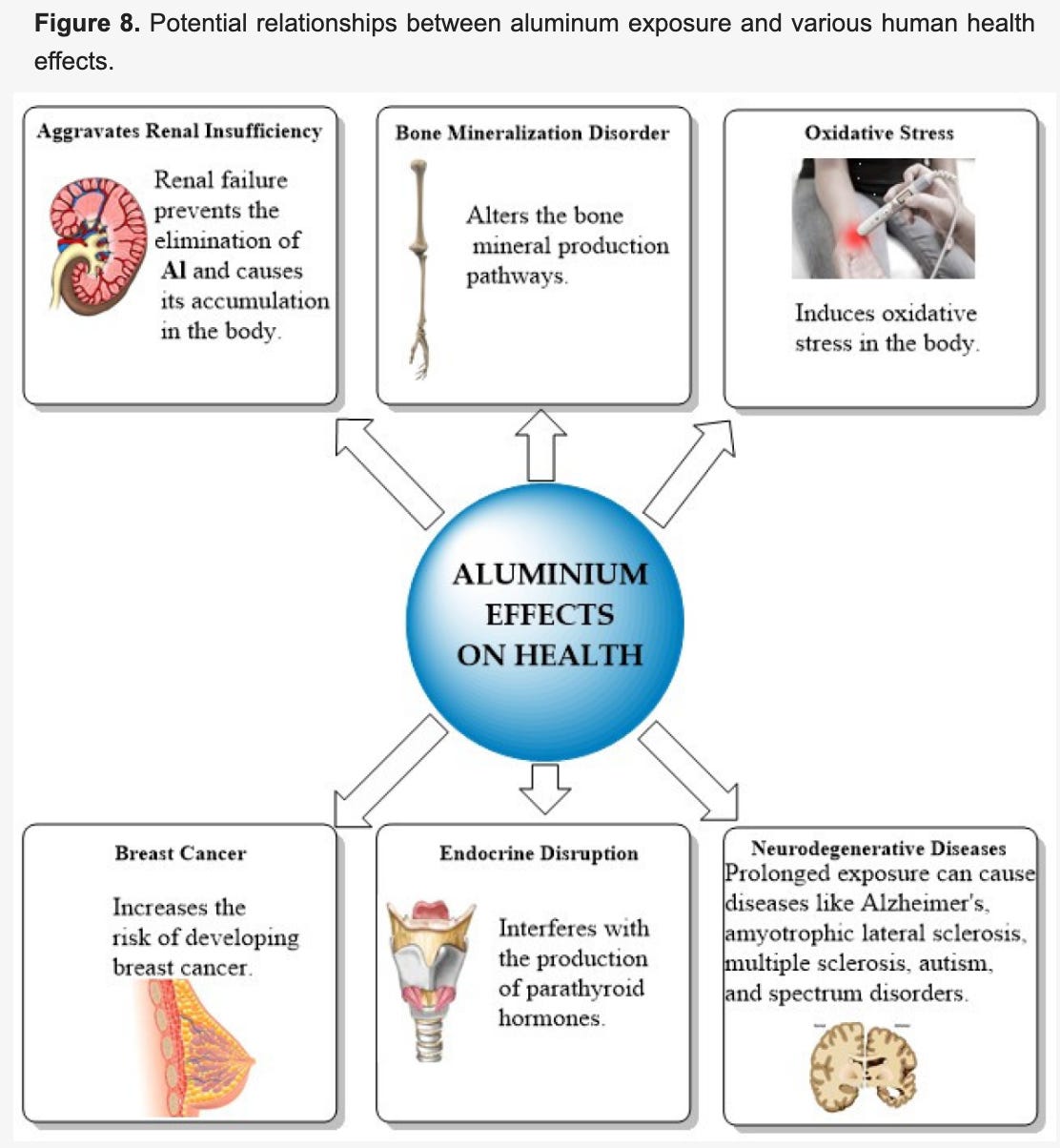
Rondeau et al found that people exposed to aluminum levels above 0.1 mg/L in drinking water had about twice the risk of developing dementia and Alzheimer’s disease compared to those with lower exposure:
The relative risk of dementia adjusted for age, gender, educational level, place of residence and wine consumption was 2.03 (95 percent CI 1.23–3.34) for subjects exposed to aluminum concentration greater than 0.1 mg/l. This result was confirmed for Alzheimer’s disease (adjusted relative risk=2.20, 95 percent CI 1.24–3.89)
The CDC has reported that many cities have aluminum concentrations as high as 0.4–1 mg/L in their drinking water. Interestingly, an increase of 10 mg/day in silica intake from drinking water is associated with a reduced risk of dementia (adjusted relative risk = 0.89, P=0.036).
In addition to these common public water supply additives, per- and poly-fluoroalkyl substances (PFAS) are estimated to be present in 45% of US drinking water.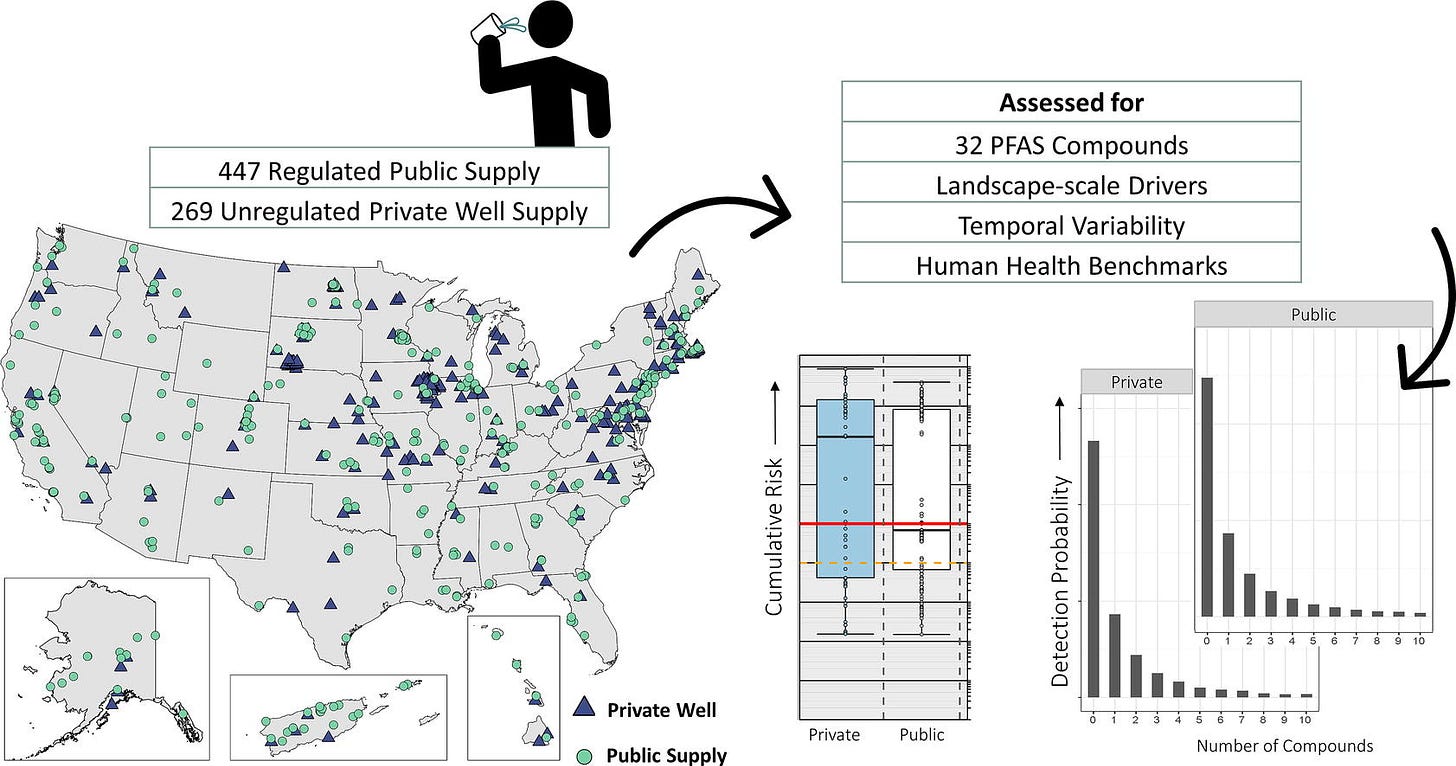
Fenton et al describes associations between exposure to specific PFAS and a variety of health effects, including altered immune and thyroid function, liver disease, lipid and insulin dysregulation, kidney disease, adverse reproductive and developmental outcomes, and cancer.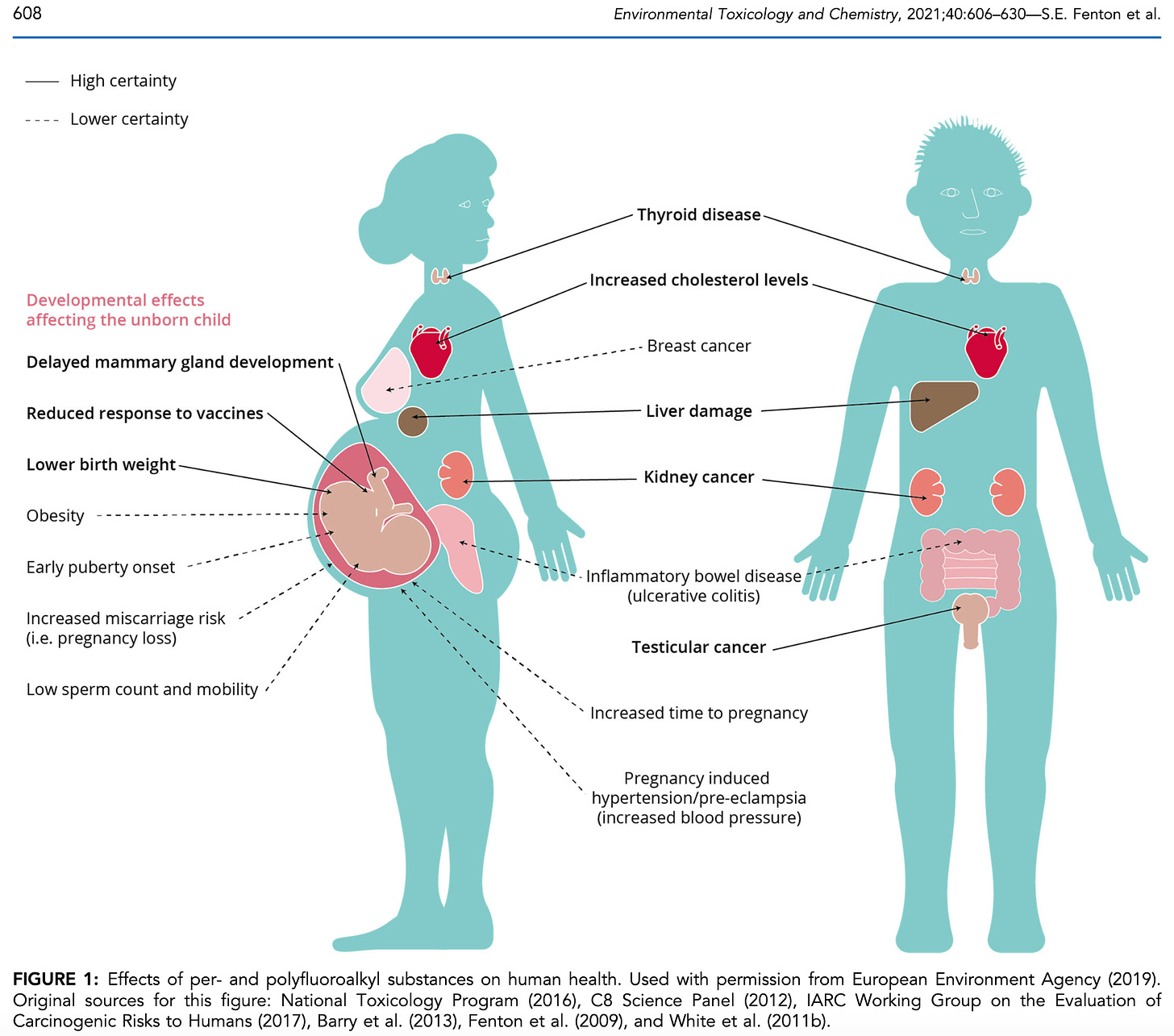
Fluoride is not considered an essential nutrient for any biological function in humans or animals. Approximately 72.3% of the U.S. population on community water systems receives fluoridated water. The CDC currently recommends a fluoride concentration in drinking water of 0.7 mg/L to prevent cavities, with a secondary safety standard of 2.0 mg/L. Physical intervention to remove fluoride from water is currently only required when fluoride concentrations exceed the EPA maximum contaminant level (MCL) of 4.0 mg/L. Boehmer et al found that between 2016 and 2021, approximately 83.7% of the time, people served by fluoridated water systems received water with fluoride levels between 0.6 mg/L and 2.0 mg/L. This implies that a significant number of Americans likely receive fluoride levels above 1.5 mg/L, which is the World Health Organization’s safe limit for fluoride. In Europe, only Ireland, Poland, Serbia, Spain, and the UK fluoridate their water. Most developed countries do not consume artificially fluoridated water.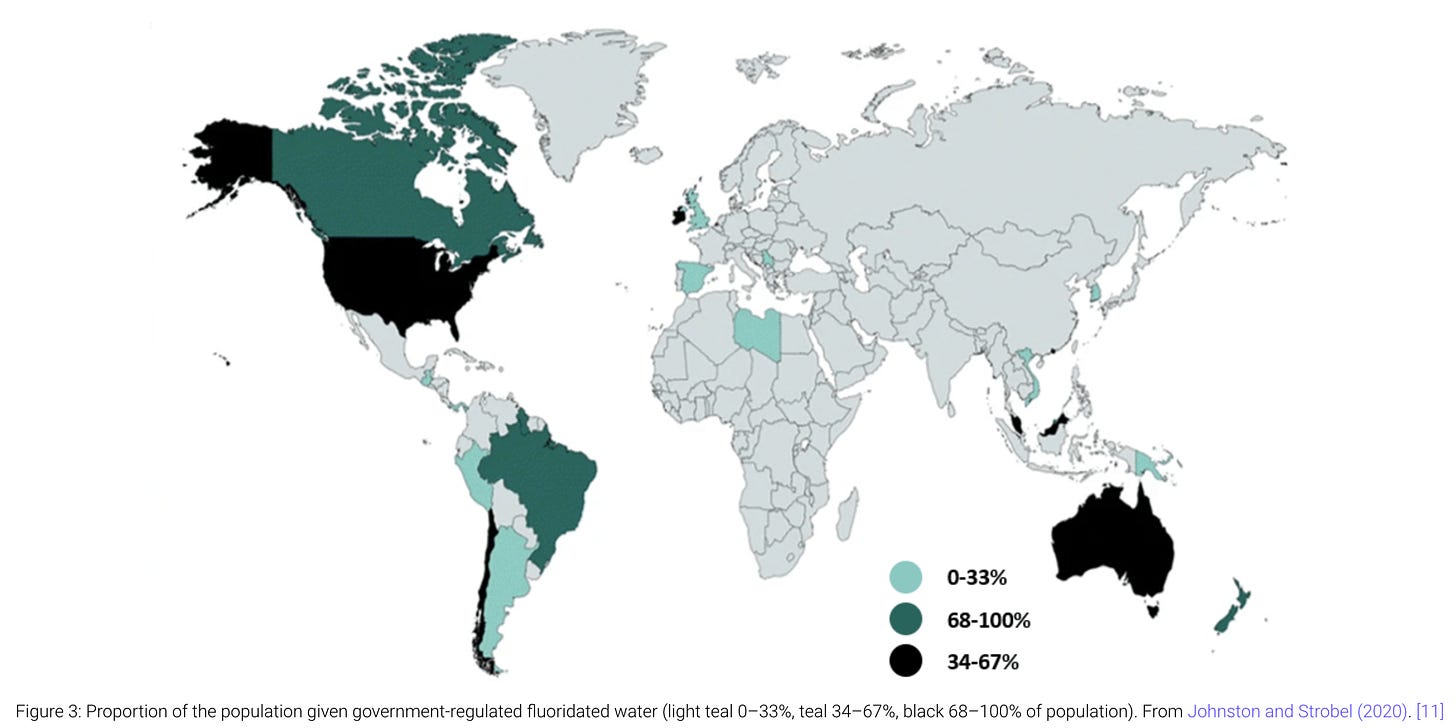
The U.S. uses fluoride derived from industrial byproducts for water fluoridation:
Three chemicals are used to fluoridate drinking water in the U.S: sodium fluoride (NaF); sodium fluorosilicate (Na2SiF6); and fluorosilicic acid (H2SiF6). Fluorosilicic acid is a byproduct of the manufacture of phosphate fertilizer. It is recovered as a vapor, which ensures a high degree of purity. Both sodium fluoride and sodium fluorosilicate are made from fluorosilicic acid recovered in this manner. Sodium fluorosilicate is created by neutralizing fluorosilicic acid with caustic soda, itself a water treatment chemical. Sodium fluoride is created by neutralizing fluorosilicic acid with sodium chloride, common salt.
Various deleterious health outcomes can occur if water fluoride concentration is above 1.5 mg/L (within the CDC’s safety standard). Kumar et al summarized the major adverse health effects on human beings due to the ingestion of excess fluoride through drinking water (above 1.5 mg/L):
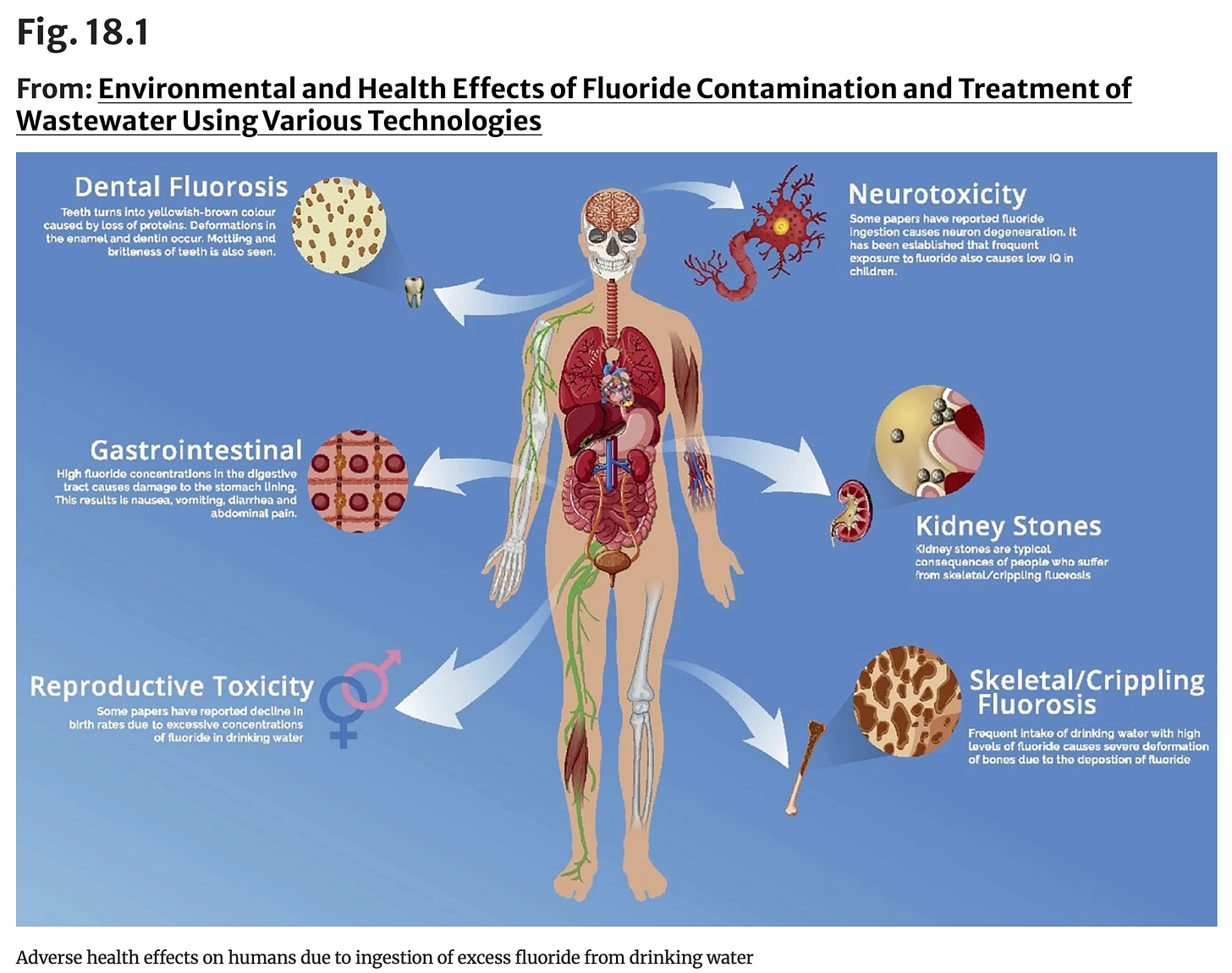
A recent U.S. Department of Health and Human Services National Toxicology Program report concluded that drinking water containing more than 1.5 mg/L of fluoride is consistently associated with lower IQs (-2 to -5) in kids. The report found 72 studies that examined fluoride exposure's impact on children's IQ. Among 19 high-quality studies, 18 reported an inverse association between estimated fluoride exposure and IQ in children. Additionally, 46 of 53 low-quality studies also found an inverse relationship. Some negative health outcomes of fluoride exposure can likely still happen at concentrations lower than 1.5 mg/L.
A new Cochrane review found that water fluoridation has only a minimal effect on the reduction in dental caries and that the benefits of fluoride in water supplies may be smaller than they were before the widespread addition of fluoride to toothpaste.
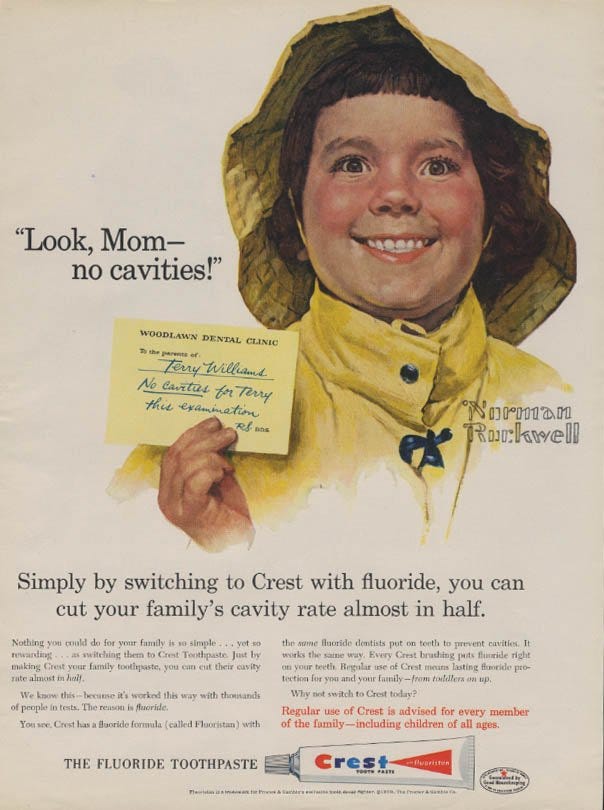 |
| Fluoride ad from 1950s |
A comprehensive review by Hujoel reveals the private interests that resulted in the wide adoption of fluoride in the 1950s. Between 1942 and 1949, the American Dental Association (ADA) engaged in significant reversals concerning three key points: the safety of topical fluoride, the role of micronutrient deficiencies in dental caries, and dietary recommendations for dental health. The ADA initially viewed fluoride with caution, associating it with potential toxicity. However, by 1947, the ADA reversed its stance and endorsed fluoride for widespread dental use, despite the absence of new safety data. The Sugar Research Foundation (SRF) played a significant role in promoting fluoride, as its research agenda aimed to protect sugar markets by shifting attention away from the harmful effects of sugar and carbohydrates on dental health. The SRF funded research and conferences that advocated for fluoride as a means to prevent dental caries, effectively shielding sugar consumption from scrutiny. The ADA, influenced by private interests and political pressures, began promoting fluoride as a public health measure, even though evidence on its broader safety remained incomplete. Additionally, organizations such as the Kellogg Foundation, known for its cereal production, had representatives involved in key ADA committees. This convergence of interests between the sugar, cereal, and dental industries, along with the ADA's pivot away from carbohydrate restriction, helped usher in the era of fluoride-supplemented, high-carbohydrate diets.
The narrow range between fluoride concentrations that provide purported benefits (0.7 mg/L) and those that pose risks (>1.5 mg/L) presents concerns, especially if fluctuations in concentration occur.
Fluoride is naturally present in the environment and most natural water sources, including bottled waters, and thus can’t be completely removed from the water supply. Some bottled water manufacturers artificially add fluoride to their water or source their water from fluoridated public water systems. Approximately 42% of American children are drinking bottled waters. Johnson and DeBiase found that 95% of the bottled water analyzed (n=65) did not label fluoride content. If there is meaningful public health policy on fluoride, the bottled water industry will have to be properly managed with respect to accurate fluoride testing and labelling.
Since it’s impossible to completely remove fluoride from the environment, gathering precise data on the number of Americans exposed to fluoride concentrations above 1.5 mg/L should be a first priority to identify and protect high-risk populations. Another key policy should be reducing the EPA maximum contaminant level (MCL) for fluoride in public drinking water systems from 4 mg/L to <0.7 mg/L, which would effectively enforce physical intervention to remove unsafe levels of fluoride and discourage artificial supplementation.
In avoiding autocracy, this approach could be a first step in collaboration with multiple stakeholders that may disagree with a complete water fluoridation ban, even if it’s indicated. Lastly, we should keep in mind that fluoride is only one element among the sea of other water treatment additives and contaminants that present similar, if not worse, negative health outcomes. To drive meaningful improvements in population health, we need a broader perspective on water and public health safety. Additionally, efforts to enhance water safety should encompass both tap and bottled water.
Sources:
- https://www.theepochtimes.com/health/fluoride-free-your-guide-to-water-filtration-and-health-5741827
- https://petermcculloughmd.substack.com/p/improving-the-safety-of-the-public
Read More: This article is part of the Fluoride and Water Safety series.

.png)
.png)






Comments
Post a Comment